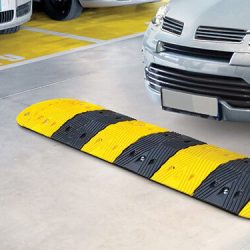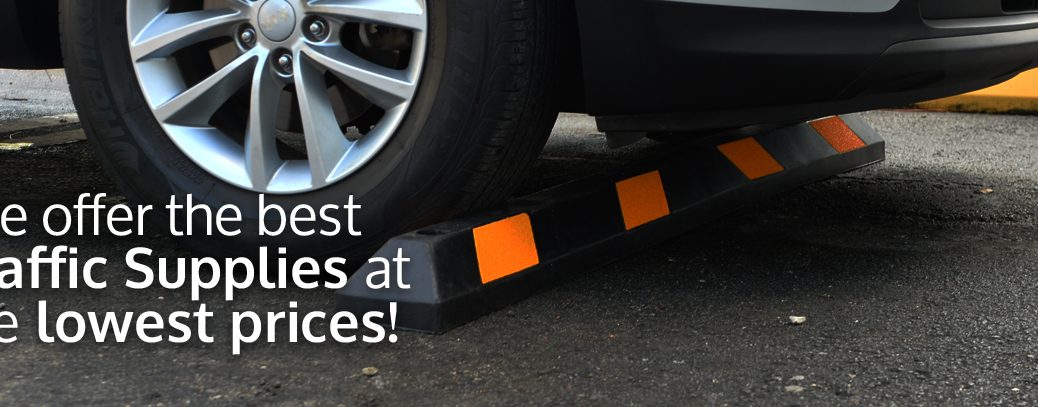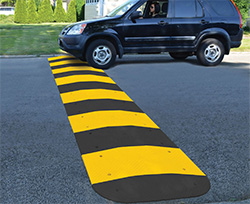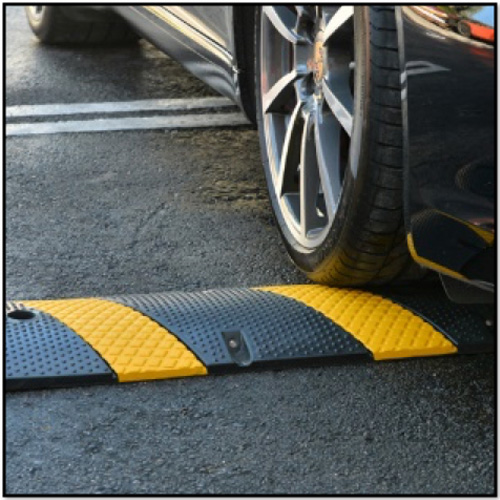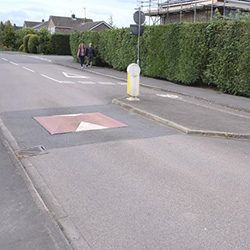Category Archives: Speed Bumps & Humps
The Impact of Speed Bumps on Traffic Noise
Understanding Traffic Calming Measures
The Art of Effective Traffic Calming: Importance of Well-Designed Speed Bumps
Introduction
Picture this: You’re cruising along your local street, and suddenly, you’re bouncing over a speed bump, or was it a speed hump? These traffic-taming titans are often mistaken for one another, yet they each play a unique role in the symphony of road safety. As conductors of the asphalt, it’s crucial to tune into the nuances that distinguish them. By the end of this harmonic exploration, we’ll have hit all the right notes to compare the effectiveness of speed bumps versus speed humps, shedding light on the common mix-up and providing a clear track for understanding their differences. So buckle up, as we embark on a journey to navigate the “humps and bumps” of traffic calming measures, and ultimately discern which of the two emerges as the maestro of moderation on our streets. Continue reading “The Art of Effective Traffic Calming: Importance of Well-Designed Speed Bumps” »Advantages of Speed Humps
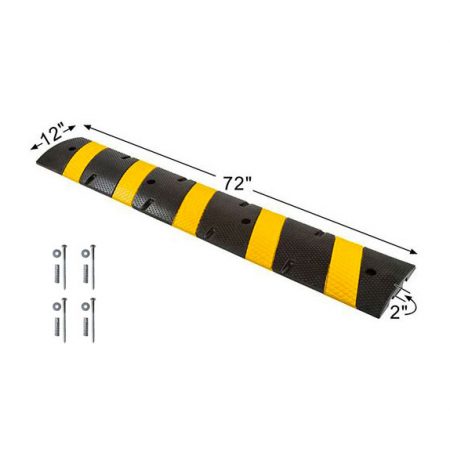 Speed humps and speed bumps, although similar, serve slightly different purposes and are beneficial in distinct scenarios. Essentially, these are physical traffic calming devices that force drivers to reduce their speed while crossing them. They are strategically placed to ensure safety, improve the flow of traffic, and protect pedestrians in areas with high foot traffic. The primary difference between the two lies in their design and the degree of speed reduction they cause. Speed humps are broad, gradual elevations in the roadway, while speed bumps are narrower and more abrupt.
Speed humps and speed bumps, although similar, serve slightly different purposes and are beneficial in distinct scenarios. Essentially, these are physical traffic calming devices that force drivers to reduce their speed while crossing them. They are strategically placed to ensure safety, improve the flow of traffic, and protect pedestrians in areas with high foot traffic. The primary difference between the two lies in their design and the degree of speed reduction they cause. Speed humps are broad, gradual elevations in the roadway, while speed bumps are narrower and more abrupt.
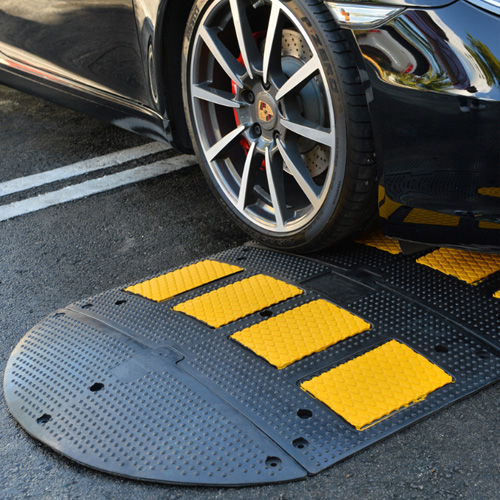 The deployment of these traffic control measures has a host of advantages and purposes. They are designed to slow down traffic particularly in residential areas, around schools, and in other pedestrian-rich zones. By encouraging drivers to navigate at reduced speeds, they significantly minimize the risk of accidents. Moreover, they play an instrumental role in facilitating a safe environment for pedestrians and cyclists.
Moreover, speed humps and bumps provide a cost-effective and practical solution compared to other physical traffic calming measures like roundabouts or one-way streets. They are less planning intensive and can be installed easily and inexpensively on a variety of existing surfaces. This makes them a preferred choice for local authorities and private areas looking for immediate and effective traffic calming solutions.
Speed humps, being larger and more gradual, are particularly useful in places where traffic needs to flow smoothly, but at a controlled pace. Meanwhile, their smaller counterparts, speed bumps, are more suitable for areas where pedestrians and vehicular traffic share space more equally. Both types, when used appropriately, can become traffic safety superstars in their own right, creating safer environments for both drivers and pedestrians.
In the following sections, we will delve deeper into the various advantages of speed humps and speed bumps, their installation considerations, and maintenance requirements. We aim to highlight their effectiveness in promoting safe driving in pedestrian zones and encouraging drivers to adhere to speed limits, thereby ensuring the safety of everyone on the road.
The deployment of these traffic control measures has a host of advantages and purposes. They are designed to slow down traffic particularly in residential areas, around schools, and in other pedestrian-rich zones. By encouraging drivers to navigate at reduced speeds, they significantly minimize the risk of accidents. Moreover, they play an instrumental role in facilitating a safe environment for pedestrians and cyclists.
Moreover, speed humps and bumps provide a cost-effective and practical solution compared to other physical traffic calming measures like roundabouts or one-way streets. They are less planning intensive and can be installed easily and inexpensively on a variety of existing surfaces. This makes them a preferred choice for local authorities and private areas looking for immediate and effective traffic calming solutions.
Speed humps, being larger and more gradual, are particularly useful in places where traffic needs to flow smoothly, but at a controlled pace. Meanwhile, their smaller counterparts, speed bumps, are more suitable for areas where pedestrians and vehicular traffic share space more equally. Both types, when used appropriately, can become traffic safety superstars in their own right, creating safer environments for both drivers and pedestrians.
In the following sections, we will delve deeper into the various advantages of speed humps and speed bumps, their installation considerations, and maintenance requirements. We aim to highlight their effectiveness in promoting safe driving in pedestrian zones and encouraging drivers to adhere to speed limits, thereby ensuring the safety of everyone on the road.
Advantages of Speed Humps
Speed humps, also known as “sleeping policemen,” have a multitude of advantages that significantly contribute to promoting safe driving, especially in zones heavily trafficked by pedestrians. Let’s delve into some of these advantages, which make speed humps an essential component of road safety management. The first and most apparent advantage is that they effectively prevent dangerous speeding. Speeding is a significant concern in pedestrian zones, and speed humps offer a simple yet effective solution to this problem. By creating a physical impediment on the road, they force drivers to slow down, thereby reducing the likelihood of accidents. This characteristic of speed humps is especially beneficial near schools, hospitals, or residential areas where the presence of pedestrians is higher. Secondly, speed humps contribute to reducing noise pollution. In areas where vehicles are consistently speeding, the noise generated can be disruptive to residents and pedestrians alike. When drivers slow down their vehicles due to the presence of a speed hump, the engine noise, tire squealing, and other noise associated with high-speed driving are significantly reduced. This reduction in noise pollution contributes to the overall quality of life in these areas. Moreover, they enhance road safety by promoting a more cautious driving behavior. When drivers are aware of the presence of speed humps, they tend to be more attentive and observant. This heightened awareness reduces the chances of unexpected incidents and contributes to the overall safety of both drivers and pedestrians. In this way, speed humps serve as a reminder for drivers to adhere to traffic rules and regulations. One of the most practical advantages of speed humps is their ease of installation. Speed humps can be installed quickly without the necessity for major reconstruction of the road. Their modular, prebuilt designs allow for installation on existing surfaces, making them a less planning-intensive solution compared to other physical traffic calming methods like roundabouts or one-way streets. This allows for traffic calming measures to be implemented swiftly, without causing significant disruption or inconvenience to road users. Finally, an often overlooked advantage of speed humps is their cost-effectiveness. Compared to other traffic calming measures, speed humps offer an inexpensive solution to slow down traffic and increase safety. Their simple design and easy installation process reduce initial costs and their durability ensures they are a long-term solution, requiring minimal maintenance. In conclusion, speed humps, with their myriad of benefits, play a crucial role in ensuring the safety of both drivers and pedestrians. They serve as a vigilant overseer, silently guiding drivers to adhere to speed limits and observe caution, thereby promoting a safer, quieter, and more peaceful environment for everyone.Advantages of Speed Bumps
Speed bumps, often seen in parking lots and residential areas, play a vital role in traffic management. Their primary purpose is to reduce the speed of the traffic, which is an essential aspect of road safety. Speed bumps are small raised areas that cause discomfort to drivers when they drive over them at high speeds, thus encouraging them to slow down. Designed for areas where traffic and pedestrians share space more evenly, they serve as a physical reminder for drivers to maintain a slower, more cautious speed. One of the most significant advantages of speed bumps is that they are an effective deterrent for dangerous speeding. Drivers are forced to slow down when approaching a speed bump to avoid damage to their vehicles, which subsequently reduces the risk of accidents. This makes speed bumps particularly useful in areas with high levels of pedestrian traffic, such as schools, parks, and residential neighborhoods, where maintaining lower speeds is crucial for protecting vulnerable road users. Another compelling advantage of speed bumps is their role in enhancing road safety. In addition to controlling speed, they can also help to increase driver awareness. The presence of a speed bump can serve as a visual indicator that drivers need to be more alert, as they are entering an area that requires careful driving. This increased level of driver attentiveness can help to prevent accidents and keep both drivers and pedestrians safer. Speed bumps are also valued for their ease of installation. They can be installed quickly and easily, making them a practical solution for immediate speed control needs. There’s a range of modular, prebuilt speed bumps available on the market, which can be installed on existing road surfaces without any major reconstruction work. This easy installation process makes speed bumps a cost-effective and efficient approach to traffic calming. Moreover, it’s worth mentioning the versatility of speed bumps. They come in a variety of sizes and materials, allowing for customization based on specific road conditions and traffic needs. Whether it’s rubber, plastic, or concrete, each material provides different levels of durability and effectiveness, offering flexibility in choosing the right solution for a particular setting. In conclusion, the advantages of speed bumps extend beyond just controlling vehicular speed. They contribute to road safety, increase driver awareness, and can be installed with minimal disruption to existing road structures. As such, speed bumps continue to be an effective, straightforward, and economical tool for promoting safe driving in pedestrian zones.Installation Considerations
The proper installation of speed humps and bumps is an essential factor in their effectiveness. Identifying the suitable location for installation is critical. The placement should be in areas where traffic calming is most required, such as within school zones, residential areas, or areas with high pedestrian traffic. The appropriate size of the speed hump or bump must be considered to ensure it serves its purpose without causing unnecessary discomfort to drivers. The material used for installation should be durable and weather-resistant, capable of withstanding heavy traffic without rapid wear and tear. Moreover, they should be conspicuous enough to be easily noticed by drivers, reducing the chances of sudden, abrupt stops that could lead to accidents.Maintenance Considerations
Just as important as the installation of speed humps and bumps is their maintenance. Regular monitoring and inspections of these traffic calming devices are crucial to ensure their durability and effectiveness. Over time, wear and tear from traffic and weather conditions can damage these devices, reducing their effectiveness. Regular cleaning and repair can address such issues, ensuring that speed humps and bumps always function as they should. Another essential maintenance consideration is the necessity of regular repainting and resurfacing. This is because visibility is a key factor in the effectiveness of speed humps and bumps. If drivers can clearly see the installations, they are more likely to slow down, thereby increasing road safety. As such, ensuring that speed humps and bumps are always clearly visible is essential. This involves regular repainting and resurfacing to not only maintain their effectiveness, but to also prolong their service life.Conclusion
The effectiveness of speed humps and speed bumps in promoting safe driving in pedestrian zones cannot be overstated. These traffic calming measures have proven their worth in countless situations, helping to maintain a balance between traffic flow and pedestrian safety. They play a crucial role in enforcing speed limits, ensuring that drivers maintain a safe speed that is conducive to the safety of all road users. Speed humps and bumps offer a multitude of benefits, one of which is their ability to prevent dangerous speeding. This, in turn, significantly reduces the risk of accidents and enhances safety for both drivers and pedestrians. This is particularly important in areas where traffic and pedestrians share the same space, as it helps to prevent any unforeseen accidents and improves the overall safety of the area. Moreover, the convenience of installing these traffic calming measures is another major plus. The installation of speed humps and speed bumps can be conducted quickly and easily, particularly when utilizing modular, prebuilt versions. This ease of installation results in less planning and substantially lower costs, making them a highly desirable choice over other, more complex traffic calming methods such as roundabouts or one-way streets. Maintenance of these speed control devices should also not be overlooked. Regular monitoring, inspections, and cleaning are paramount to ensure their longevity and maximum effectiveness. Regular repainting and resurfacing are also crucial to maintain visibility and safety. It’s important to remember that the effectiveness of speed humps and bumps is reliant on their being in excellent condition, and hence, regular maintenance should be a priority. In conclusion, speed humps and bumps are indeed traffic safety superstars, promoting a safer environment for both motorists and pedestrians. They not only control the speed of vehicles but also enhance overall safety, reduce noise pollution, and can be installed and maintained with relative ease. As such, they are a cost-effective, efficient, and impactful solution that significantly contributes to safer roads and pedestrian zones. While every effort should be made to install such measures in areas where they can have the most impact, the responsibility does not rest solely on the shoulders of traffic planners. The effectiveness of speed humps and bumps also relies heavily on drivers adhering to speed limits and respecting the purpose of these devices. By doing so, we can all contribute to a safer and more harmonious co-existence between vehicles and pedestrians in shared spaces.Recent Posts
What’s the difference between speed bumps and speed humps?
Definition of Speed Bumps
Speed bumps, as their name suggests, are traffic calming devices used primarily to slow down vehicles in specific areas. They are engineered structures often made from asphalt, concrete, recycled plastic, rubber, or metal. Visually, speed bumps can be identified as raised areas of pavement that stretch across the width of the road. Typically, they are about 6 to 12 inches in width and 3 to 4 inches in height. The primary use of speed bumps is in areas where the reduction of vehicle speed is considered essential for safety purposes. These include residential neighborhoods, school zones, parking lots, and other pedestrian-heavy areas. The abrupt nature of speed bumps forces drivers to reduce their speed significantly to avoid discomfort or potential vehicle damage.Definition of Speed Humps
Speed humps, sometimes inaccurately referred to as ‘speed bumps’, are traffic calming devices designed to make roadways safer for pedestrians and drivers. They are typically broad, rounded, and elongated, extending across the full width of the roadway. Constructed from asphalt, plastic, rubber, or metal, speed humps are generally 3 to 4 inches high and 10 to 14 feet wide. Speed humps serve the primary function of slowing down vehicle speeds, usually to 10-20 miles per hour, ideal for residential areas, schools, and parks where the pedestrian presence is high. They are engineered to make drivers reduce speed over a longer distance, causing less abrupt deceleration and acceleration compared to the more aggressive speed bumps. They’re highly effective in promoting safe driving habits and reducing the likelihood of accidents.Differences Between Speed Bumps and Speed Humps
While both speed bumps and speed humps are designed for the same purpose – to slow down vehicle traffic – there are key differences between the two. These differences can be sorted under two categories: physical and functional differences. Understanding these variances is vital to making an informed decision on what is best suited for your specific needs. Starting with the physical differences, speed bumps are typically smaller and taller than speed humps. Generally, speed bumps measure about 3 to 6 inches in height and are usually less than a foot wide. Due to their size, drivers need to come to a near-stop when traversing over them, making them an effective solution for areas where extremely slow speeds are necessary. On the other hand, speed humps are broader and lower than speed bumps. They tend to be about 3 to 4 inches in height and can extend up to 14 feet in width. This width allows vehicles to traverse over them at a moderate speed without causing discomfort to the passengers or damage to the vehicle. Therefore, speed humps are commonly used in areas where slowing traffic is necessary, but not to the extent of forcing a near-stop. Beyond the physical elements, there are also functionality differences between speed bumps and speed humps. Speed bumps, due to their size and height, have a dramatic impact on vehicle speed, reducing it to around 5 mph. This makes them ideal for areas like parking lots, driveways, and private lanes, where pedestrian safety is paramount. Speed humps, despite being used to slow down traffic, allow for a smoother transition and affect vehicle speed less dramatically than speed bumps do. Their design allows vehicles to maintain a speed of around 15 to 20 mph, making them suitable for residential roads, school zones, and other areas where the goal is to moderate, not drastically reduce, vehicle speed. The impact on vehicles is another important aspect to consider when comparing speed bumps and speed humps. Due to their abrupt and taller design, speed bumps can cause more noticeable discomfort to vehicle passengers and potentially more stress on the vehicle itself, especially if traversed at higher speeds. Speed humps, with their gentler, sloping design and wider span, lead to a less jarring experience for passengers and are less likely to cause vehicle damage. In conclusion, while both speed bumps and speed humps serve the same basic function of slowing vehicle traffic, they are not interchangeable. Their differences in size, impact on vehicle speed, and effect on passenger comfort and vehicle stress need to be taken into account when deciding which is most appropriate for a given setting.Advantages and Disadvantages
There are notable advantages and disadvantages to both speed bumps and speed humps. The main advantage of speed bumps is that they are very effective at reducing speed, as they require vehicles to nearly stop to pass over them comfortably. They are especially suitable for parking lots and private roads, where controlling speed is of utmost importance. On the other hand, speed humps, while not as abrupt as speed bumps, still effectively slow down vehicles. Their design allows for a smoother transition, making them ideal for public roads and residential areas, where maintaining traffic flow is crucial. However, both have their downsides as well. Speed bumps, due to their aggressive design, can cause discomfort to drivers and may even damage vehicles if not approached correctly. Speed humps, while smoother, can still be a nuisance, particularly for emergency vehicles that need to maintain a faster speed. Both can also lead to increased noise from braking and acceleration, which can be disruptive in residential areas. In summary, both speed bumps and speed humps have their specific applications and should be chosen based on the specific speed control needs of an area.Conclusion
In conclusion, both speed bumps and speed humps play crucial roles in traffic management, ensuring the safety of pedestrians and vehicles on our roads. However, they exhibit notable differences in terms of design, functionality, and impact on vehicles. A summarized understanding of their features and uses can help you make an informed decision on which traffic calming measure to implement in your area. Speed bumps, which are usually higher and narrower, are designed to control speed in areas such as parking lots and private roads. They are abrupt, therefore forcing vehicles to slow down significantly when driving over them. However, their stark physical structure may potentially cause damage if a vehicle traverses them at high speed. On the other hand, speed humps, characterized by their broad, rounded design, are best suited for residential areas and streets with low speed limits. They allow for a smoother transition, reducing the risk of vehicle damage, while still effectively slowing down speeding vehicles. However, they may cause delays for emergency vehicles which is a significant drawback. In terms of advantages, speed bumps are highly effective in slowing down vehicles to almost a halt, thereby enhancing pedestrian safety. They are also easier to recognize due to their abrupt design. Regarding speed humps, they have a more widespread use due to their gentle, gradual design which allows vehicles to maintain a slightly faster speed compared to speed bumps. This is beneficial on roads where slow but continuous traffic flow is required. Speed bumps and speed humps also come with their fair share of disadvantages. Speed bumps can potentially cause damage to vehicles if driven over at high speed, and they may also disrupt the flow of traffic. Speed humps, while less jarring to vehicles, may cause delays for emergency services as they still require vehicles to slow down. Based on these insights, the choice between speed bumps and speed humps ultimately comes down to your specific requirements. If you need to enforce a very low speed limit, speed bumps might be the appropriate choice. In contrast, if you need to slow down vehicles without disrupting traffic flow too much, speed humps could be the more suitable option. In making this decision, it is crucial to consider the nature of the area, the type of vehicles that frequent it, and the desired speed limit. This comprehensive understanding will ensure the chosen traffic calming measure serves its purpose effectively.Speed Bumps for Parking Lots
What are speed bumps?
Speed bumps are devices used to slow down traffic on roads and highways. They are typically made up of rubber and are designed to lessen the impact of a vehicle by absorbing some of the energy created by a car’s momentum. Speed bumps are a common traffic calming measure that is used to reduce vehicle speeds in areas where safety is a concern. They are typically made of asphalt or concrete and are designed to be a series of small, raised bumps that force drivers to slow down. In this post, we will explore the history of speed bumps, their effectiveness, and some of the controversies surrounding their use. The first speed bumps were installed in the United Kingdom in the 1970s as a way to slow down traffic in residential areas. Since then, they have become a popular traffic calming measure around the world. Speed bumps are often used in areas where there are high volumes of pedestrian traffic, such as school zones, parking lots, and residential streets. One of the main benefits of speed bumps is that they are an effective way to reduce vehicle speeds. Studies have shown that speed bumps can reduce vehicle speeds by up to 50%1. This can be especially important in areas where there are high volumes of pedestrian traffic, as it can help to reduce the risk of accidents. However, there are also some controversies surrounding the use of speed bumps. One of the main concerns is that they can be damaging to vehicles. If a vehicle is driven over a speed bump too quickly, it can cause damage to the suspension, tires, and other parts of the vehicle. This can be especially problematic for emergency vehicles, which need to be able to respond quickly to emergencies. Another concern is that speed bumps can be inconvenient for drivers. If a driver is forced to slow down for a speed bump, it can add time to their journey. This can be especially frustrating for drivers who are in a hurry or who are driving long distances. Despite these concerns, speed bumps remain a popular traffic calming measure around the world. They are relatively inexpensive to install and can be an effective way to reduce vehicle speeds in areas where safety is a concern. However, it is important to weigh the benefits and drawbacks of speed bumps before deciding whether or not to install them in a particular area. In conclusion, speed bumps are a common traffic calming measure that can be effective in reducing vehicle speeds. While there are some concerns about their use, they remain a popular choice for areas where safety is a concern. If you are considering installing speed bumps in your area, it is important to carefully weigh the benefits and drawbacks before making a decision.How do rubber speed bumps work?
When a vehicle passes over the rubber speed bumps, the rubber absorbs some of the energy created by the car’s momentum and this reduces the speed of the car significantly.What is the purpose of rubber speed bumps?
The purpose of rubber speed bumps is to slow down traffic on roads and highways to reduce the risk of accidents.Are rubber speed bumps effective?
Yes, rubber speed bumps are an effective way to slow down traffic and reduce the risk of accidents on roads and highways.Speed bumps for sale
Check out the fantastic deals on speed bumps now available for sale! You can purchase speed bumps with express delivery options and take advantage of bulk discounts. To learn more about our products or to request a personalized quote for larger orders, please contact our sales team.Distinguishing Between Speed Bumps and Speed Humps
Both speed humps and speed bumps serve as vertical deterrents on the road, ensuring adherence to the designated speed limit. Understanding the disparity between speed bumps and speed humps is crucial for making an informed purchasing decision. Speed humps, though slightly smaller than speed bumps, are longer and prove most effective in maintaining traffic speeds between 10 and 15 MPH. On the other hand, speed bumps are better suited for controlling speeds between 2 and 10 MPH. In residential areas, drivers commonly encounter a series of speed humps, while speed bumps are typically employed to impede speed in specific locations, such as parking lots. Uncertain about whether to choose a speed bump or a speed hump? Feel free to contact us to determine which option aligns best with your specific needs.High-quality speed bumps
High-quality speed bumps are traffic calming devices designed to slow down vehicles and improve road safety. They are typically installed in areas where speeding is a concern, such as residential neighborhoods, school zones, parking lots, and commercial areas. We offer you speed bumps that are engineered and constructed to meet specific standards to ensure effectiveness, durability, and minimal disruption to drivers.Premium speed bumps factory
“Premium speed bumps” is not a standardized term, and the features of such speed bumps can vary depending on the manufacturer and specific use case. However, premium speed bumps generally refer to high-quality, well-designed, and durable traffic calming devices that are often used in areas where safety and traffic management are of utmost importance. If you are looking for a speed bump maker or speed bumps suppliers in USA you can trust us. Our rubber speed humps are are designed to improve pedestrian safety and reduce the risk of accidents on residential streets, parking lots and driveways.Heavy duty speed bumps
Heavy-duty speed bumps are robust traffic calming devices designed to withstand high levels of traffic, including large vehicles and trucks, while effectively reducing speed and enhancing road safety. These speed bumps are typically used in areas where heavy traffic is a concern, such as industrial zones, distribution centers, logistics hubs, and areas with significant truck or bus traffic.Conclusion
Summary of findings
Summary of findings: In conclusion, Unimat Industries’ speed bumps have proven to be highly durable and effective in standing up to extreme weather conditions. The materials used in their construction, such as high-density polyethylene and rubber, have been found to be resistant to cracking, fading, and warping even in harsh environments. Additionally, the design of the speed bumps allows for easy installation and maintenance, making them a practical and reliable solution for traffic calming measures in various settings. Overall, Unimat Industries’ speed bumps are a top choice for those seeking a long-lasting and weather-resistant traffic management solution.Implications for road safety
The durability and effectiveness of Unimat Industries’ speed bumps in extreme weather conditions have significant implications for road safety. In areas prone to heavy rainfall, snow, or extreme heat, traditional speed bumps may become damaged or ineffective, posing a risk to drivers and pedestrians. However, Unimat’s speed bumps are designed to withstand these conditions, ensuring that they remain visible and functional even in harsh weather. This means that drivers can rely on them to slow down and navigate safely through high-risk areas, reducing the likelihood of accidents and improving overall road safety.Recommendations for future research
In order to further improve the durability and effectiveness of Unimat Traffic‘ speed bumps in extreme weather conditions, future research could focus on testing different materials and designs. Additionally, conducting long-term studies on the wear and tear of the speed bumps in various weather conditions could provide valuable insights for potential improvements. Furthermore, exploring the use of innovative technologies, such as self-healing materials or sensors that can detect changes in temperature and adjust the speed bump accordingly, could also be a promising avenue for future research. Next Steps: Unimat Industries is committed to providing top-quality speed bumps that can withstand extreme weather conditions. If you’re interested in learning more about our products or would like to place an order, please visit our website at https://unimatindustries.com. Our team of experts is always available to answer any questions you may have and help you find the perfect solution for your needs. Don’t wait any longer to improve safety and traffic flow in your parking lot or roadway. Contact Unimat Industries today!Where should speed bumps be placed?
Speed Bumps Vs. Speed Humps: Which One Is More Effective?
Picture this: You’re cruising along your local street, and suddenly, you’re bouncing over a speed bump, or was it a speed hump? These traffic-taming titans are often mistaken for one another, yet they each play a unique role in the symphony of road safety. As conductors of the asphalt, it’s crucial to tune into the nuances that distinguish them. By the end of this harmonic exploration, we’ll have hit all the right notes to compare the effectiveness of speed bumps versus speed humps, shedding light on the common mix-up and providing a clear track for understanding their differences. So buckle up, as we embark on a journey to navigate the “humps and bumps” of traffic calming measures, and ultimately discern which of the two emerges as the maestro of moderation on our streets.
What are Speed Bumps and Speed Humps?
Imagine the rumble and the abrupt jolt – that’s the signature calling card of a speed bump. These raised mounds of pavement are like the strict librarians of the road, shushing oncoming traffic to a whisper-quiet crawl. Their purpose? To dramatically reduce speed and bolster safety, especially in parking lots and residential areas. Speed bumps are often shorter in length but pack a punch with their height, making them hard to ignore even for the most lead-footed drivers. Conversely, speed humps are the gentle giants of the traffic world. They stretch wider across the road, like a speed bump that’s hit the gym and bulked up. Their gradual incline is designed to minimize disruption, allowing vehicles to glide over at reduced speeds without the herky-jerky stop-and-go. This makes them particularly suitable for larger thoroughfares where maintaining a steady but controlled flow of traffic is key. While both speed bumps and humps share a common goal of pacing the pedal-pushers, their differences are crucial in determining their respective effectiveness in various environments.Speed Bumps & Humps
Design and Installation Differences
When it comes to taming the wild steeds of the asphalt jungle, not all traffic calming devices are created equal. Enter the design and installation differences between speed bumps and speed humps. These differences aren’t just a matter of semantics; they’re the bread and butter of traffic management. Speed bumps, with their abrupt profile, are like the strict teachers of the road—demanding a significant slow down, they are often shorter in length but taller in height. Imagine a mini Mount Everest in the middle of the street, and you’ve got the picture. On the flip side, speed humps are the gentler cousins, with a broader, more gradual rise and fall that’s less likely to spill your morning coffee.- Speed bumps are typically installed in low-traffic areas like parking lots or private roads.
- Speed humps, with their less aggressive approach, are more suited for residential streets where maintaining a smoother traffic flow is important.
Effectiveness in Reducing Speed
When it comes to putting the brakes on speeding vehicles, both speed bumps and speed humps throw their weight around, but in different arenas. Speed bumps, notorious for their abrupt profile, are like the strict teachers of traffic school—demanding a near-complete halt from drivers, thus they are incredibly effective in slowing down traffic in high-pedestrian areas. On the other hand, speed humps, with their more gentle undulation, are the cool substitutes—slowing things down without causing too much of a ruckus, making them better suited for residential roads where maintaining a steady flow is crucial.- Speed Reduction: Speed bumps trump humps when it comes to slashing speed, known to reduce vehicle velocity to around 2-10 mph.
- Safety Concerns: However, the aggressive nature of speed bumps can sometimes lead to safety issues, such as loss of vehicle control or damage to the undercarriage, if not approached correctly.
Impact on Traffic Flow
When it comes to orchestrating the dance of vehicles on our roads, speed bumps and speed humps play a pivotal but distinct role. Speed bumps, with their abrupt elevation, tend to bring cars to a near-halt, creating the automotive equivalent of a pause in a symphony. This abrupt slowing can cause a ripple effect, resulting in a choppy, staccato rhythm in traffic flow. It’s a necessary pause for safety, but one that can be jarring for the tempo of travel. In contrast, speed humps are the gentler cousins, stretching across the road like a long sigh. They encourage a more moderate deceleration, allowing traffic to maintain a smoother, more allegro pace. However, it’s not all smooth sailing; the broader design can still present disruptions, particularly for emergency vehicles, public transportation, and the two-wheeled ballet of cyclists. The tempo slows, yet the movement continues, more adagio than allegro, but fluid nonetheless.- Emergency vehicles may find speed humps less disruptive than speed bumps, yet any form of traffic calming can add precious seconds to response times.
- Public transportation, such as buses, navigate more comfortably over humps than bumps, preserving the tempo for passengers.
- For cyclists, a hump might be a mere ripple in the road, whereas a bump could be a full stop in their urban melody.
Maintenance and Cost Comparison
When it comes to deciding whether to install speed bumps or speed humps, a critical aspect to consider is the maintenance and cost associated with each. Let’s dive into the financial pool of these traffic-calming measures and see which one might require a bigger budget lifejacket!- Maintenance: Speed bumps, due to their more aggressive design and the higher impact they absorb from vehicles, may need more frequent repair. On the flip side, speed humps, with their gentle slopes, tend to wear the cloak of durability a bit better, requiring less maintenance over time.
- Installation Costs: Both speed bumps and humps come with different price tags. Speed bumps often cost less upfront because of their smaller size, making them the go-to option for budget-conscious communities. However, speed humps, though potentially more costly initially, could prove to be the economic tortoise winning the race, thanks to their lower maintenance needs.
- Long-term Costs: Considering the longevity of the installation, speed humps may end up being more cost-efficient, as the frequency of repairs is lower, leading to reduced long-term expenses. Conversely, the potentially higher maintenance frequency for speed bumps might see costs accumulate faster than dust on a neglected bookshelf.
Considerations for Choosing Between Speed Bumps and Speed Humps
When the rubber meets the road – quite literally – in the decision between speed bumps and speed humps, there are several key factors to consider. As we’ve navigated the twists and turns of their differences, it’s clear that both serve the noble purpose of reigning in those lead-footed drivers. But when it comes down to the wire, choosing the most suitable option for your stretch of asphalt isn’t a one-size-fits-all affair.- Location, Location, Location: Consider the environment. Is this a high-pedestrian area like a school zone where the abrupt nudge of a speed bump is necessary? Or is it a residential street where a gentler, elongated hump will maintain a smooth but controlled flow?
- Type of Traffic: Think about who’s rolling over these traffic taming tools. Are emergency vehicles often barreling down this boulevard, potentially needing a less disruptive hump? Or will lower, slower traffic like public transportation and cyclists be navigating this obstacle course?
- Speed Limit Goals: Envision the desired pace of vehicles. Speed bumps are the tortoises of the traffic world, enforcing a slow crawl, while speed humps are the hares, allowing for a quicker yet restrained race.




